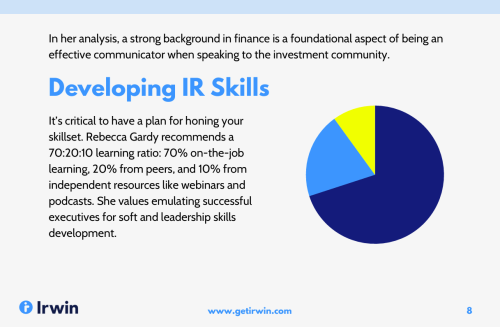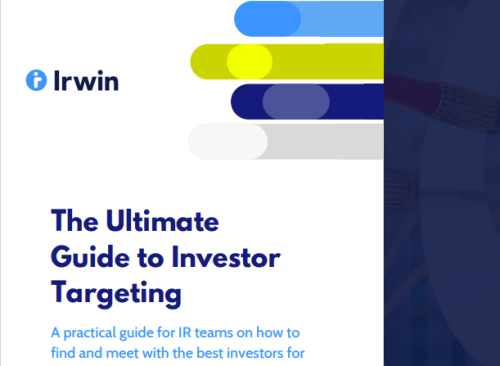 Investment decisions often result from years of relationship building, research and marketing, but IROs face growing pressure to attract capital, stabilize stock prices and position their company favorably within the financial community.
Investment decisions often result from years of relationship building, research and marketing, but IROs face growing pressure to attract capital, stabilize stock prices and position their company favorably within the financial community.
Tailored outreach lets you prioritize relationships with the most promising and valuable potential investors. In an era where investors are overwhelmed by calls and emails, a strategic approach increases the likelihood that investors will be receptive to your communications and less likely to disregard them.
Build a strategic target list
The first step in any investor targeting exercise is to build a list of targets – investors that are the right fit for your company based on their current investment strategies and the characteristics of the companies they invest in. Strategically identifying and engaging with compatible investors enables companies to boost investor confidence, increase liquidity and reduce stock volatility.
Creative options to find new investors
Coupled with an extensive database and investor targeting solution, there are creative datasets that can give IROs more context and uncover investors they might previously have overlooked.
– Creative filtering: Outside of standard filters such as peer ownership, creative filtering can surface additional targets you may have overlooked. Looking at investors that invest in your company’s geography, market cap, sector and sub-sector and then layering on their investment style, for example, can narrow down your list.
– Non-reporting investors: Many investor databases include only institutional ownership, which leaves opportunity on the table for firms that have the potential to take a meaningful position in your company. Up to 60 percent of holders are non-reporting for certain issuers, so exploring alternate databases with comprehensive investor profiles can uncover new opportunities.
– Website visitor data: Thousands of investors browse investor relations and corporate websites daily for information. Historically, this information has been anonymized by website analytics providers so, while you could see how many visitors your website had, you didn’t know who they were. Using a tool to identify relevant web visits from investors that may be a good fit for their company, IR teams can unlock a new level of investor intent and reach out at precisely the right time.
Building an outreach and engagement strategy
It’s important to recognize that a robust targeting and engagement strategy is not a one-time exercise, nor can you ‘set it and forget it’. Your list will naturally evolve and change as your company does. But you often need multiple relationship-building interactions over months or years before an investor will take a position.
Tailored outreach and relationship-building tactics
There are many opportunities to tailor your investor outreach, from the initial email or phone call to ongoing engagements and events. Keeping your target list at the center of your strategy is a core element to ensure that whenever the opportunity arises, you can thoughtfully engage and educate investors on why they should invest.
Use important events to touch base
Although consistently sharing significant news with potential investors would be ideal, maintaining regular engagement through periodic updates is also effective. For instance, offering to connect during quarterly earnings announcements provides a low-pressure opportunity to discuss positive outcomes or continuous progress within your company.
Similarly, when conducting non-deal roadshows (NDRs) in specific locations, reaching out to firms on your target list allows your management team to engage with them.
‘When we announce earnings, I’ll reach out to the firms on my target list and ask them whether they want to have a call to touch base and talk through the quarterly results. That’s a good way to get the ball rolling and get them interested, and then I’ll follow up if we’re doing an NDR and we’re going to be in a specific city’ – Scott Einberger, investor relations officer, JLL
Leverage your relationships
IROs interact with members of the investment community as part of their daily role and leveraging those relationships for introductions or insight can help your outreach or make it more personalized.
For example, sell-side analysts who cover your sector can help build your model and support it with background research that portfolio managers use to make decisions. Corporate access groups can provide access to their networks of investors and facilitate meaningful conversations to help you build stronger relationships in proximity to your target investors.
Existing shareholders can also support introductions to target investors, especially if it means positive outcomes for their existing investment.
Outreach that supports future company goals
Proactivity can mean you have access to the right investors before a major development or change in your organization might require a different type of investor.
Building relationships with investors is important for the future of your company, as well as the present. Keep track of which investors are interested in your potential and keep them informed and engaged, so you will be ready to secure their investment when the right opportunity arises.
‘And that’s when you need to identify which relationships you know are at risk and so transition into more of a balanced operating mode, and which investors aren’t currently in your stock that might be interested in buying it, maybe not at the current valuation, but at some future date when valuation, expectations and execution begin to align.
‘Now, that might be six months out, that might be a year out, that might be two years out. You might be having conversations with a portfolio manager for 18 months before he or she even starts a tracker position in your stock. You’re trying to keep those folks informed so that when those opportunities do align, they’re ready to pull the trigger’ – Rodney Nelson, vice president of investor relations, Twilio
Measure, optimize, adapt
As you build and execute your investor targeting strategy, always ensure you measure what matters to understand what works and what doesn’t and how your efforts contribute to meaningful results for your IR program and your company.
Tips for measuring what matters
- CRM data: Use an investor relationship management & CRM solution to tag, track and report your engagements with your target investors. This will allow you to see how the relationship evolves over time, what forms of outreach work best and how many touchpoints it takes before an investor takes a position. Having a historical record also creates operational effectiveness, ensuring context is always available when someone on your team meets with a prospective investor.
- Understand what drives interest: Effective engagement tools can let you know the effectiveness of your outreach and what is driving meaningful engagement with your targets. Measuring email open and reply rates, for example, or website visits and engagement from your target investors after press coverage, events or earnings calls, or other meaningful developments, can provide insight into the most effective media and channels.
- Positions taken or changed: Measuring position changes can give you an idea of your outreach effectiveness, but it’s not always best to wait until 13Fs are filed. Leveraging stock surveillance for real-time analysis of institutional and retail holding changes and setting up ownership change alerts can keep you ahead of the game and ready to engage at the right moment.










